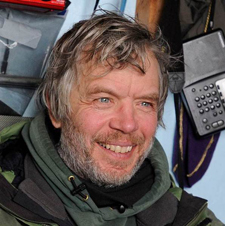Dr. George Divoky
 Studying the Black Guillemots of Cooper Island has largely been a solitary venture for Dr. George Divoky. While the discovery and initial years of the study were part of governmental research related to oil development in northern Alaska, for the past four decades the work has been conducted with occasional grants and much personal dedication. Long-term studies, such as George’s, rarely can be conducted by the government, which typically focus on immediate agency needs, while the duration of most academic research is insufficient to allow exposition of multi-decadal trends. Yet it is precisely this type of extended data set that is needed to monitor the long-term cycles and trends related to climate change and other atmospheric variation.
Studying the Black Guillemots of Cooper Island has largely been a solitary venture for Dr. George Divoky. While the discovery and initial years of the study were part of governmental research related to oil development in northern Alaska, for the past four decades the work has been conducted with occasional grants and much personal dedication. Long-term studies, such as George’s, rarely can be conducted by the government, which typically focus on immediate agency needs, while the duration of most academic research is insufficient to allow exposition of multi-decadal trends. Yet it is precisely this type of extended data set that is needed to monitor the long-term cycles and trends related to climate change and other atmospheric variation.
George Divoky is the founder of Friends of Cooper Island and serves as its director in collaboration with a governing board. George has been studying seabirds in arctic Alaska since 1970 and holds a Ph.D. from the University of Alaska Fairbanks. Research priorities and directions are set with the advice of a Scientific Advisory Board composed of prominent arctic researchers from a number of disciplines.
George’s long-term research on Cooper Island was the focus of a New York Times Magazine cover story entitled “George Divoky’s Planet” by Darcy Frey.
The Birdwatcher Who Saw The Future
Research Copies
If you’d like PDFs of any of George Divoky’s research, please email us at info@cooperisland.org and we’d be happy to share them with you!
-
Access Dr. Divoky′s Work on Google Scholar
Current list of 77 articles covering Cooper Island Arctic Research dating back to 1971.
-
Access Dr. Divoky′s Work on ResearchGate
Current list of 47 publications on Cooper Island Arctic Research dating back to 1971.
-
Read Dr. Divoky′s Field Notes
Field Notes are Dr. Divoky’s blog posts from notable happenings on the ice during his field seasons. Other entries frame up the insights he finds after returning to analyze his research.